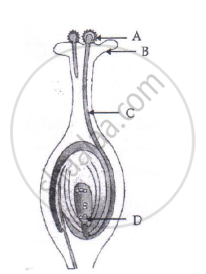Advertisements
Advertisements
प्रश्न
A student is asked to study the different parts of an embryo of pea seeds. Given below are the essential steps for the experiment :
(I) Soak the pea seeds in plain water and keep them overnight.
(II) Cut open the soaked seed and observe its different parts.
(III) Take some pea seeds in a petri dish.
(IV) Drain the excess water. Cover the seeds with a wet cotton cloth and leave them as it is for a day.
The correct sequence of these steps is
(A) III, I, IV, II
(B) III, IV, I, II
(C) III, I, II, IV
(D) III, II, I, IV
उत्तर
To study different parts of embryo, the student will first take some pea seeds in a petri dish. After that, he/she will soak seeds in plain water and keep them soaked overnight. Next day, he/she will drain the excess water and cover the seeds with wet cotton cloth for a day. Next day, he/she will cut open the soaked seeds and observe them.
Hence, the correct option is A.
APPEARS IN
संबंधित प्रश्न
Name the parts labelled as A, B, C and D in the diagram given below:-


(i) Name the part marked 'A' in the diagram.
(ii) How dose 'A' reachese part 'B'?
(iii) State the importance of the part 'C'.
(iv) What happens to the part marked 'D' after fertilisation is over?
What is the name of female organ of a flower (other than carpel)?
Fill in the following blank with suitable word :
Pollen grains contain ............ gametes of a plant.
State whether the following statement is true (T) or false (F):
Flowers which possess stamens and carpel are called unisexual.
Draw a diagram of the longitudinal section of a flower and label the following parts.
The ovule of an angiosperm is technically equivalent to ______
Antipodal cells are present towards the ______ in an anatropous ovule.
Draw the diagram of a flower and label the four whorls. Write the names of gamete producing organs in the flower.
Explain the post fertilization changes that occur in the ovary of a flower.
